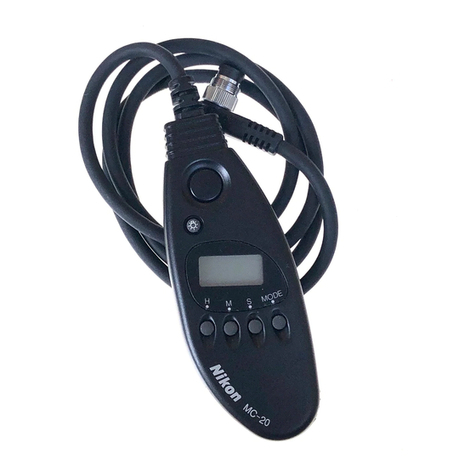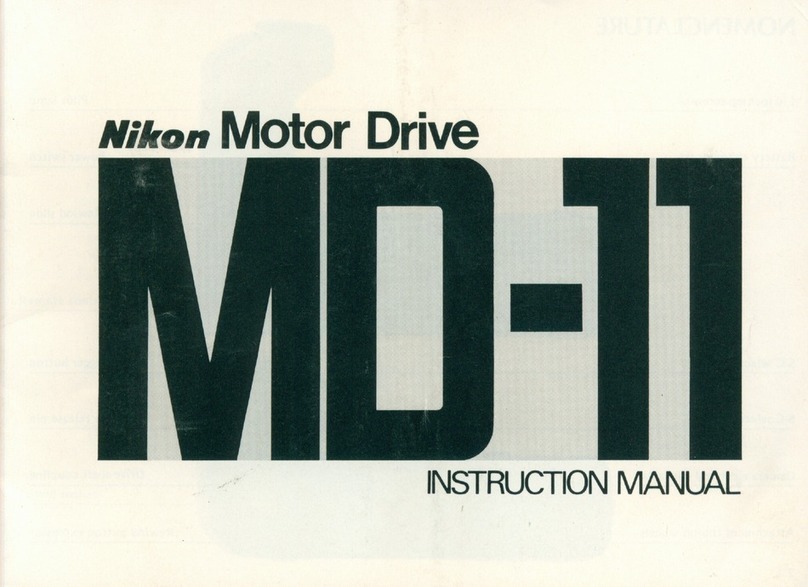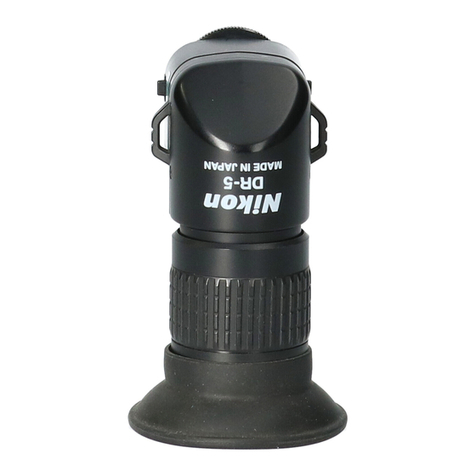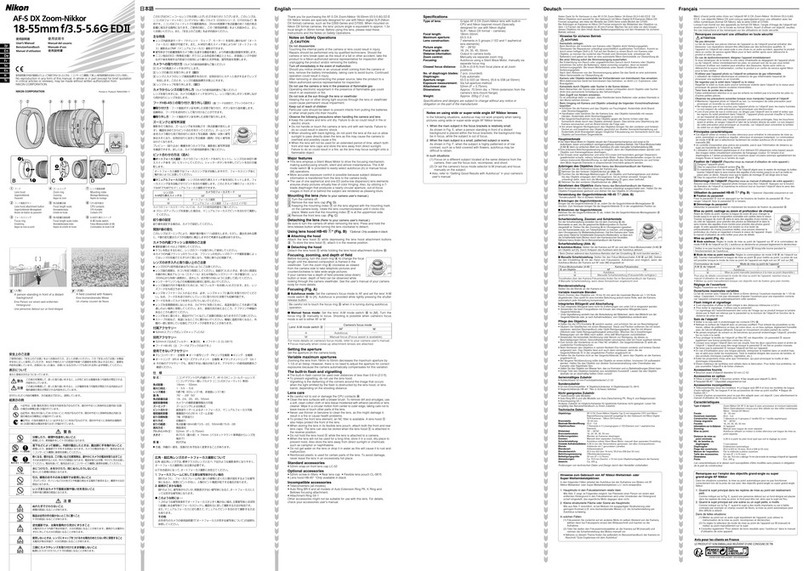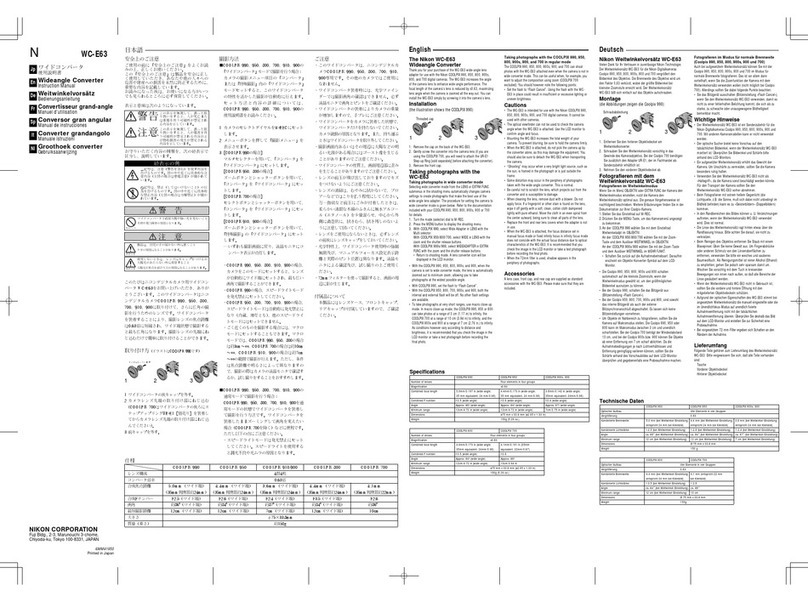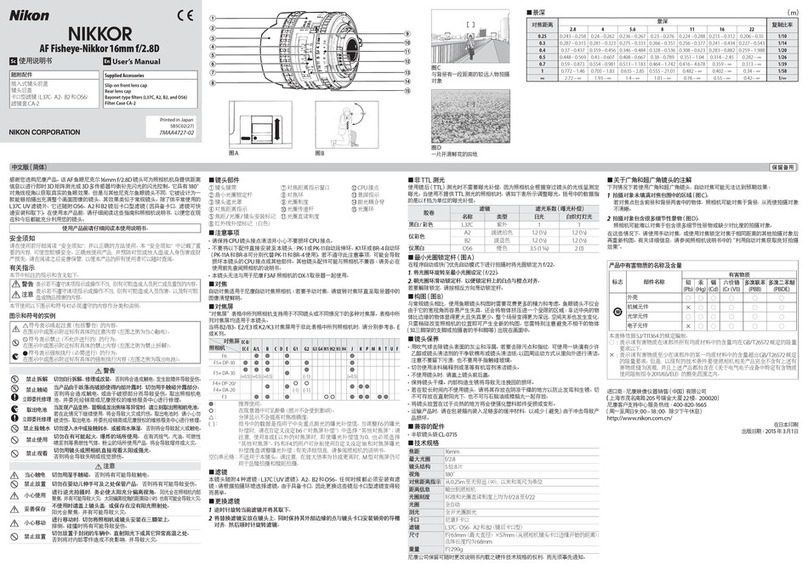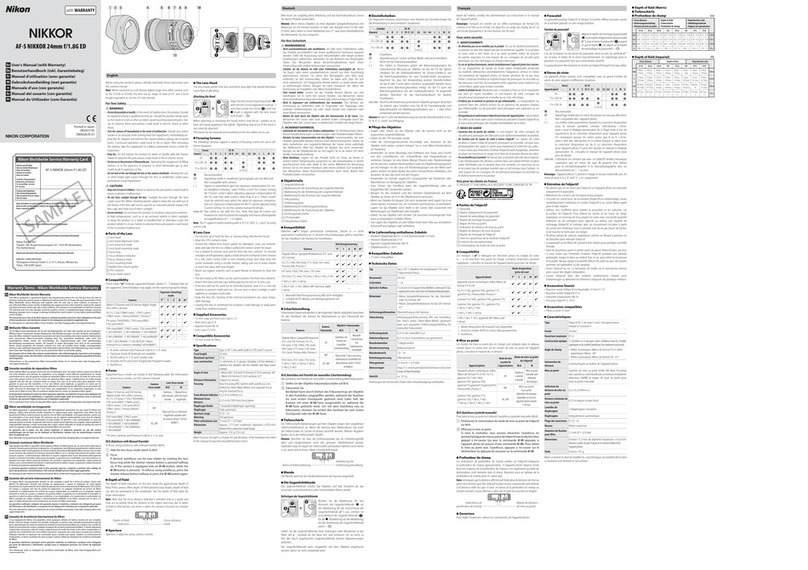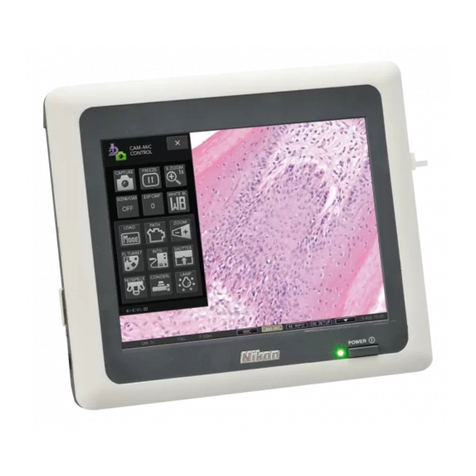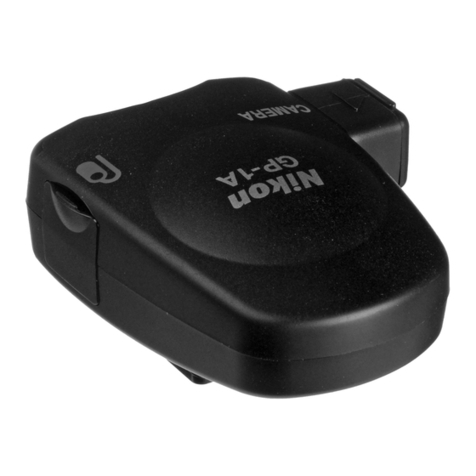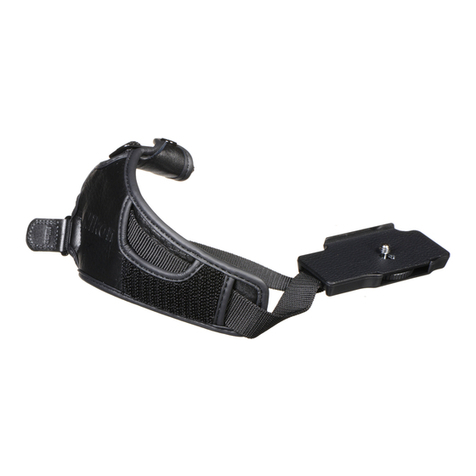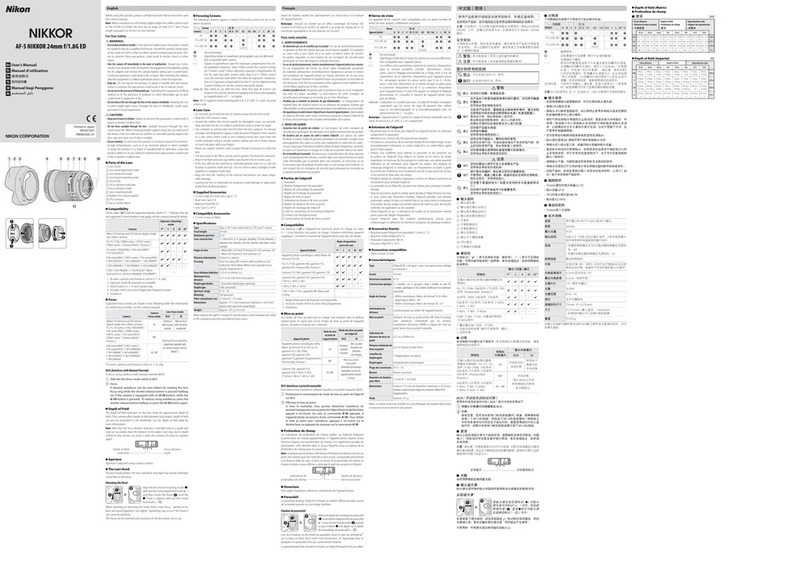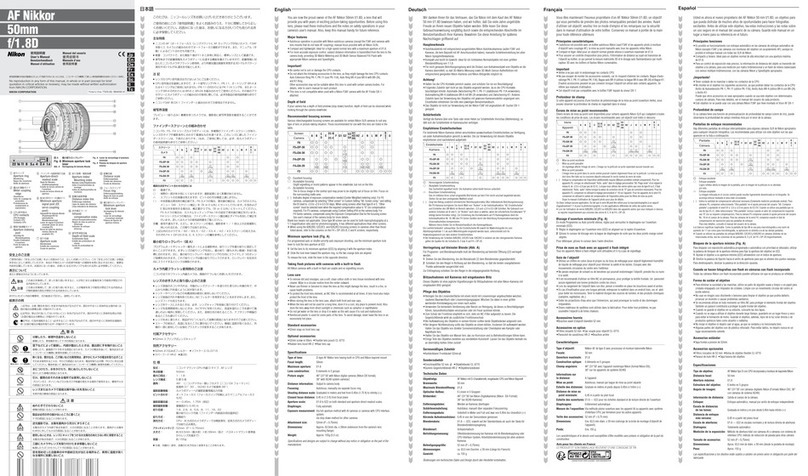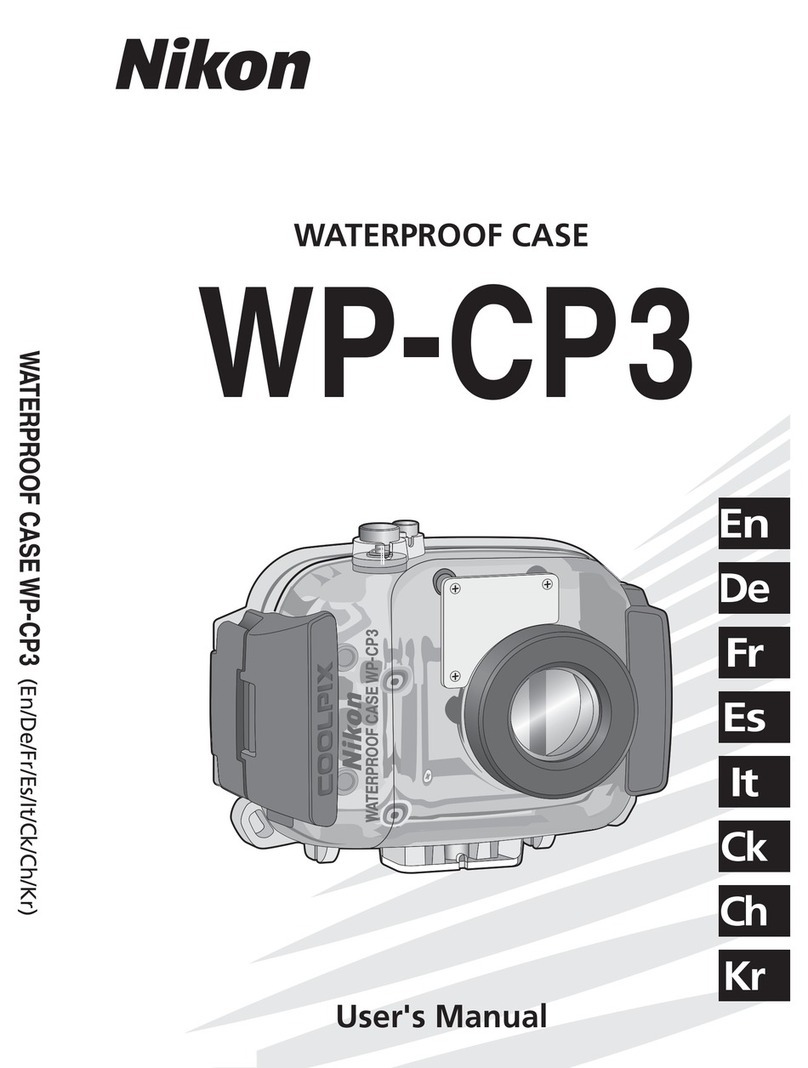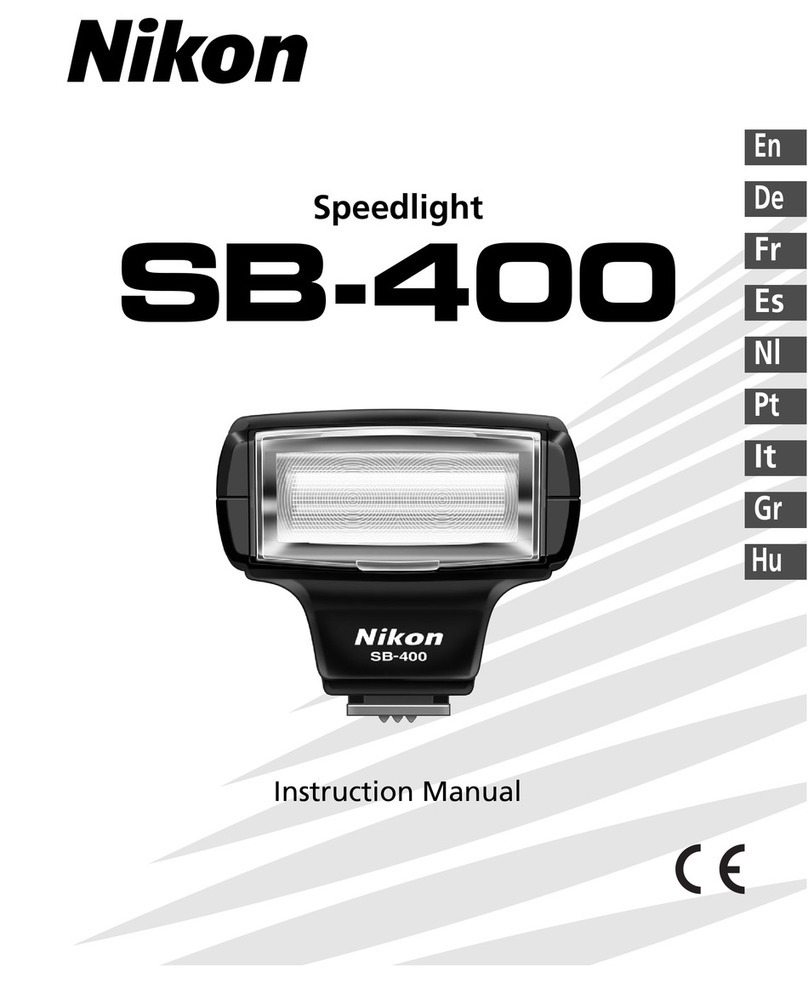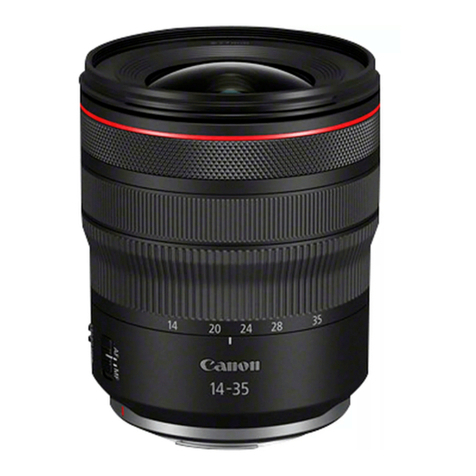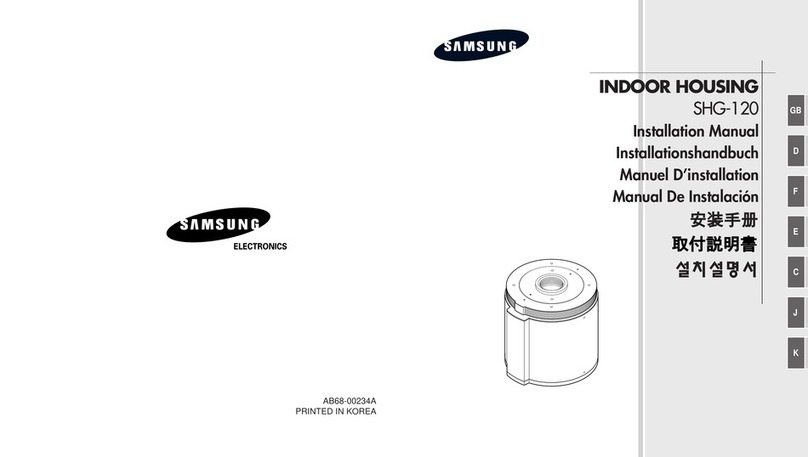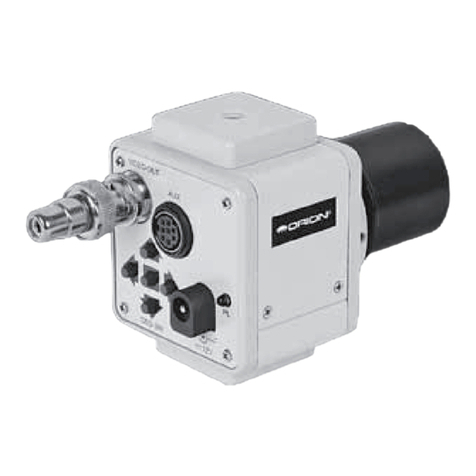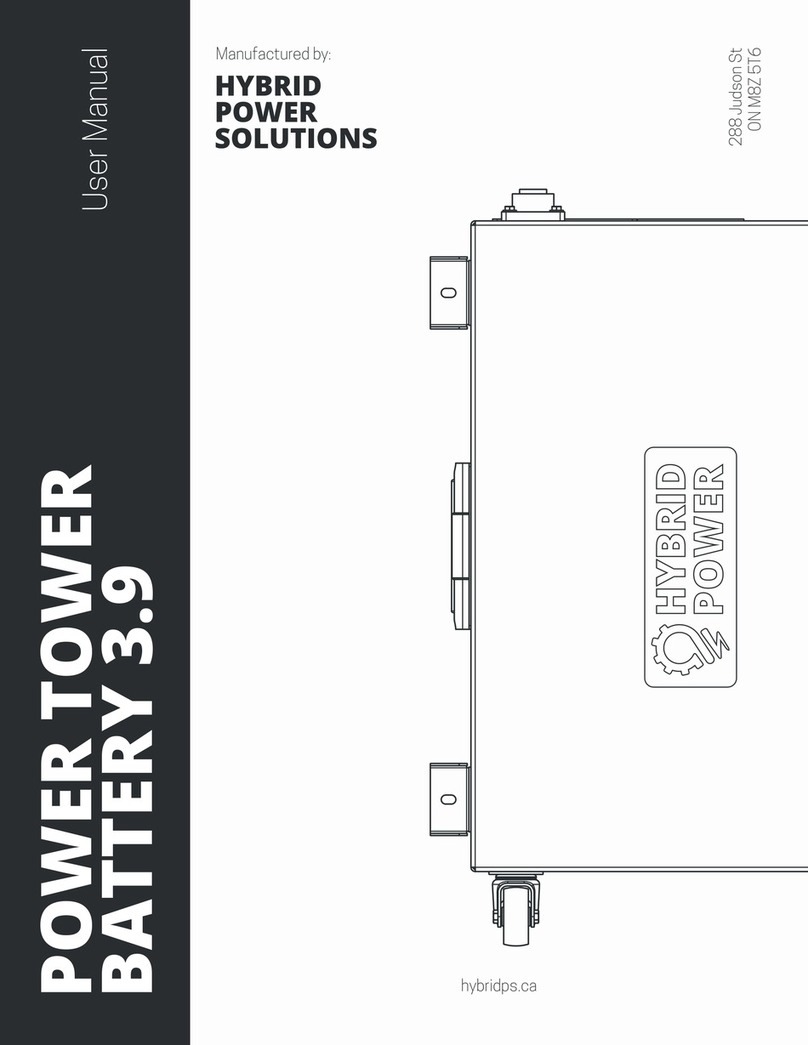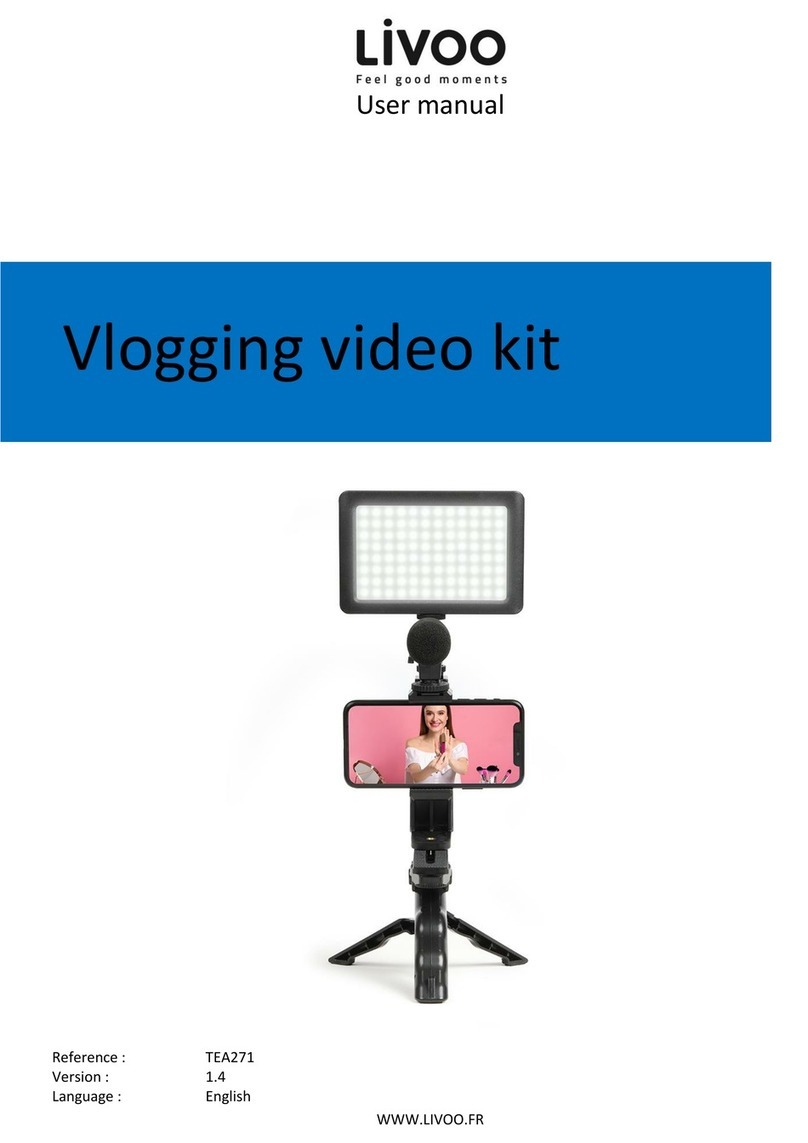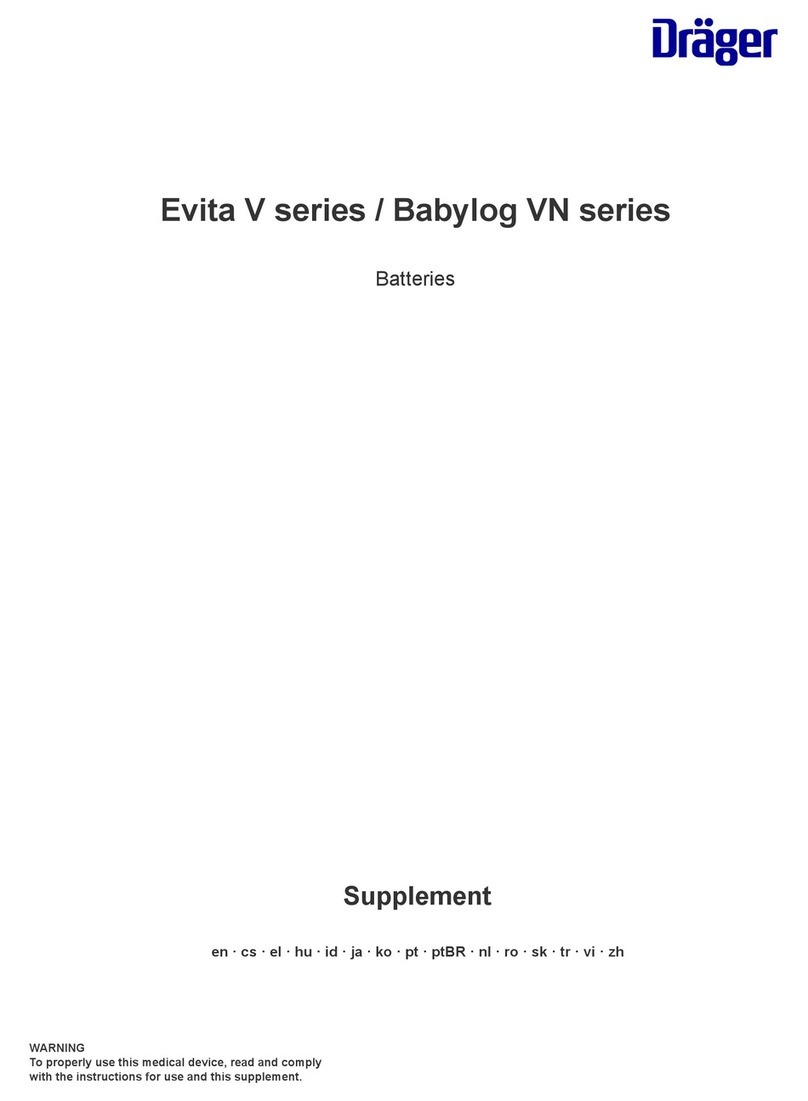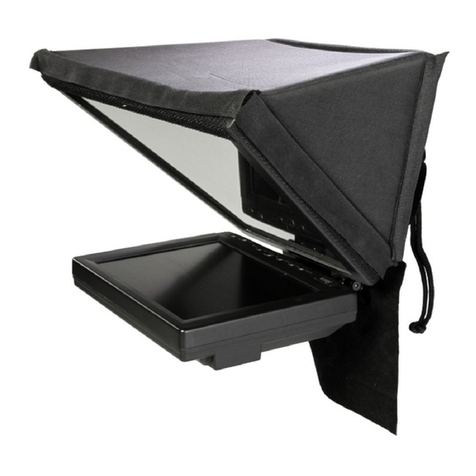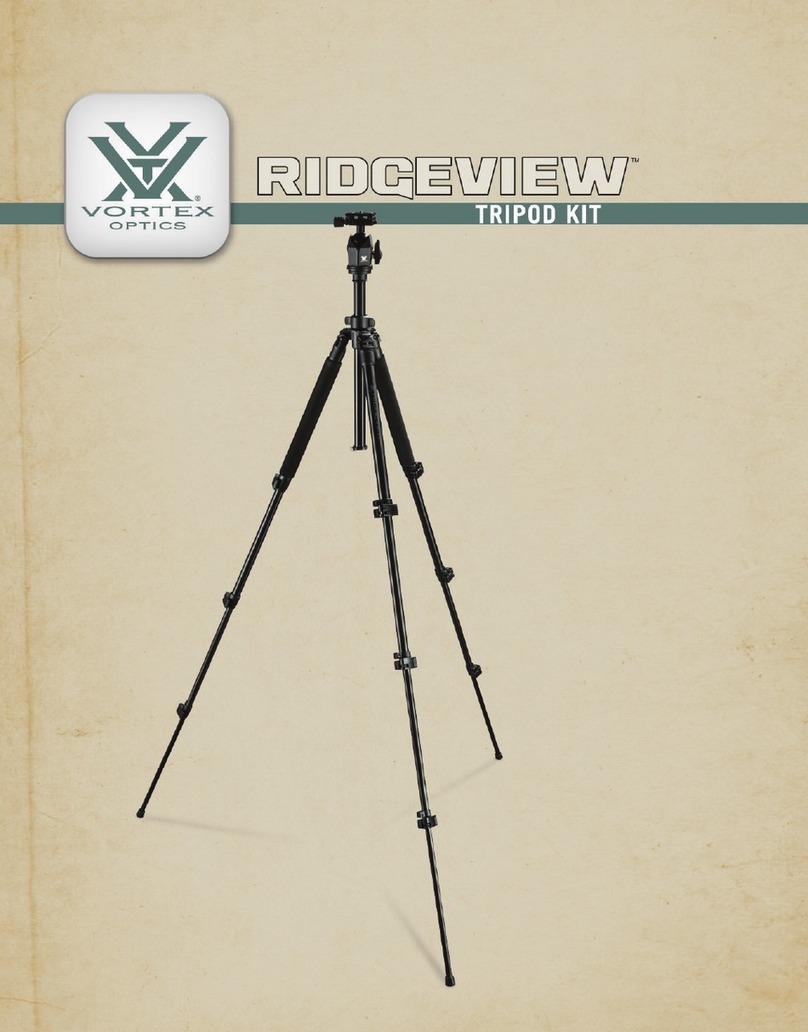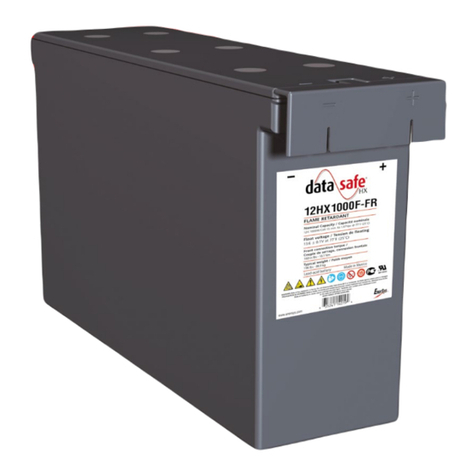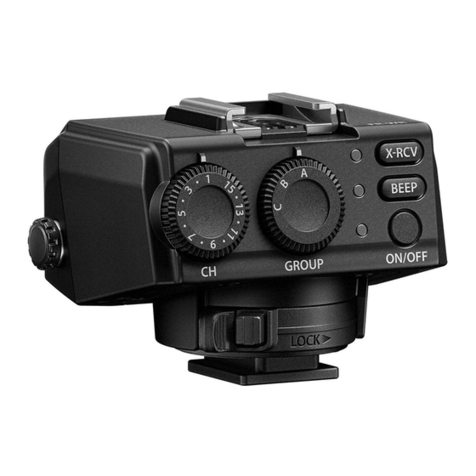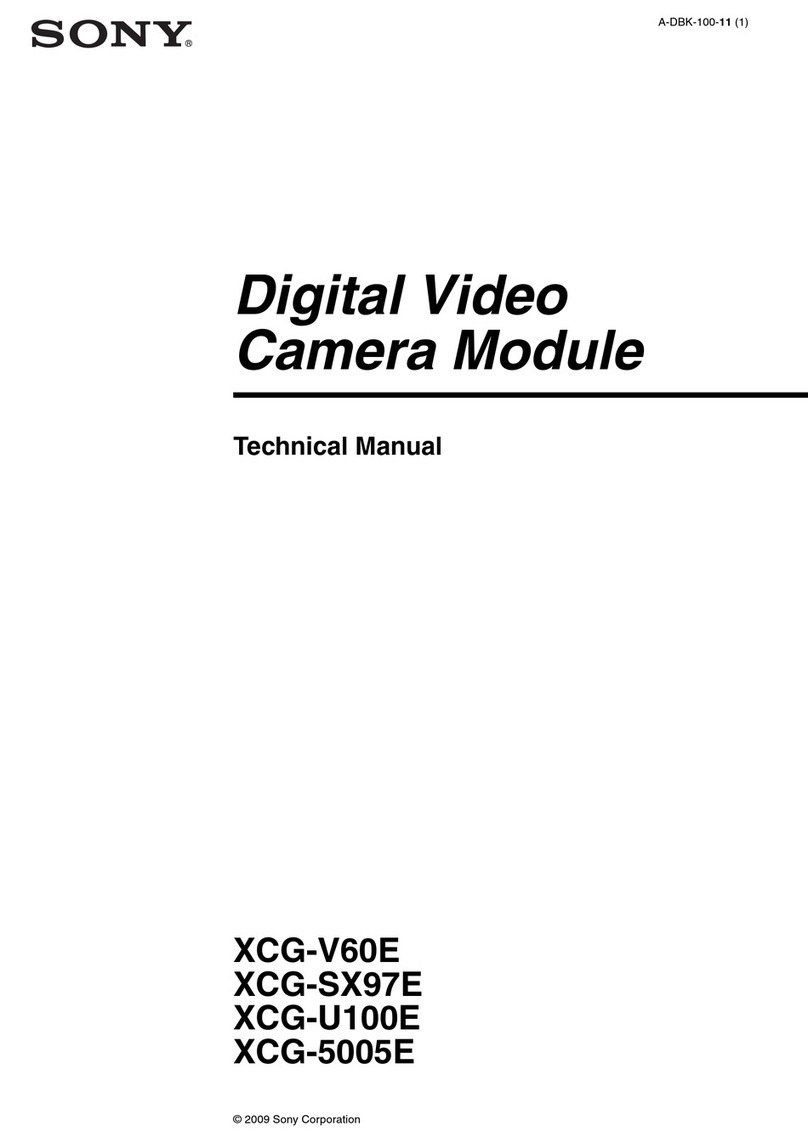
Deutsch
Vielen Dank, dass Sie sich für ein DX-NIKKOR-Objektiv entschieden haben. Bitte
lesen Sie vor der Verwendung dieses Produkts sowohl diese Anleitung als auch
das Handbuch der Kamera sorgfältig.
Hinweis: DX-Objektive sind für den Gebrauch an digitalen Spiegelreflexkameras
mit Bildsensor im DX-Format ausgelegt, wie zum Beispiel die D7100 oder D5300.
Der Bildwinkel eines Objektivs an einer DX-Format-Kamera entspricht dem
Bildwinkel eines Objektivs mit einer etwa 1,5-mal längeren Brennweite an einer
Kleinbildkamera.
Autofokus und Einstellhilfe funktionieren bei allen Brennweiten. Beim Gebrauch
dieses Objektivs können Sie alle Abschnitte im Kamerahandbuch ignorieren, in
denen Einschränkungen bezüglich Autofokus und Einstellhilfe für Objektive mit
geringerer Lichtstärke als 1:5,6 aufgeführt werden.
Für Ihre Sicherheit
A
SICHERHEITSHINWEISE
• Nicht auseinanderbauen. Das Berühren der Innenteile von Kamera oder Objektiv
könnte zu Verletzungen führen. Im Falle einer Fehlfunktion sollte das Produkt
ausschließlich von einem qualifizierten Fachmann repariert werden. Sollte das
Produkt nach Herunterfallen oder wegen anderer Einwirkungen aufbrechen,
entfernen Sie den Kamera-Akku bzw. trennen Sie den Netzadapter vom Netz
und bringen Sie das Produkt zur Inspektion zum Nikon-Kundendienst.
• Schalten Sie die Kamera im Falle einer Fehlfunktion unverzüglich ab. Wenn Sie Rauch
oder einen ungewöhnlichen Geruch aus Ihrer Ausrüstung wahrnehmen,
trennen Sie sofort den Netzadapter vom Netz bzw. entfernen Sie den Kamera-
Akku. Geben Sie dabei acht, dass Sie sich nicht verbrennen. Der fortgesetzte
Betrieb könnte zu einem Brand oder zu Verletzungen führen. Bringen Sie
nach Entnahme des Akkus die betroffenen Geräte zur Inspektion zum Nikon-
Kundendienst.
• Nicht in Gegenwart von entammbarem Gas verwenden. Der Betrieb von
Elektrogeräten in Gegenwart von entflammbarem Gas könnte zu einer
Explosion oder zu einem Brand führen.
• BlickenSienicht durchdas Objektiv oderden Kamerasucherindie Sonne. Das Betrachten
der Sonne oder einer anderen hellen Lichtquelle durch das Objektiv oder den
Sucher kann zu bleibenden Schäden am Auge führen.
• Außerhalb der Reichweite von Kindern aufbewahren. Ein Nichtbeachten dieser
Vorsichtsmaßnahme kann zu Verletzungen führen.
• Beachten Sie folgende Vorkehrungen beim Umgang mit Kamera und Objektiv:
-Schützen Sie Objektiv und Kamera vor Feuchtigkeit. Andernfalls könnte es
zu einem Schaden am Produkt, einem Brand oder Stromschlag kommen.
-Bedienen Sie die Kamera oder das Objektiv nicht mit nassen Händen.
Andernfalls besteht die Gefahr eines Stromschlags.
-Halten Sie die Sonne sicher außerhalb des Bildbereiches, wenn Sie Motive
im Gegenlicht aufnehmen. Sonnenstrahlen, die in der Kamera gebündelt
werden, wenn sich die Sonne im oder in der Nähe des Bildausschnitts
befindet, können zu einem Brand führen.
-Wird das Objektiv für längere Zeit nicht verwendet, bringen Sie den vorderen
und hinteren Objektivdeckel an und lagern Sie das Objektiv an einem Ort
ohne direkte Sonneneinstrahlung. Wird es in direktem Sonnenlicht gelagert,
könnte das Objektiv die Sonnenstrahlen auf entflammbare Objekte
fokussieren und diese entzünden.
• Tragen Sie Stative nicht mit montierter Kamera oder montiertem Objektiv. Es besteht
die Gefahr zu stolpern oder versehentlich andere Personen zu stoßen, was zu
Verletzungen führen kann.
• Bewahren Sie das Produkt nicht an Orten auf, an denen es extrem hohen Temperaturen
ausgesetzt ist, wie beispielsweise in einem geschlossenen Auto oder direkt in der Sonne.
Das Missachten dieser Vorsichtsmaßnahme könnte einen Schaden oder einen
Brand verursachen.
■
Objektivteile (
Abbildung
)
qGegenlichtblende *
wMarkierung für die Arretierung der Gegenlichtblende
eMarkierung für die Ausrichtung der Gegenlichtblende
rMarkierung für das Ansetzen der Gegenlichtblende
tZoomring
yBrennweitenskala
uMarkierung für Brennweitenskala
iFokussierring
oMarkierung für die Ausrichtung des Objektivs
!0 Dichtungsmanschette
!1 CPU-Kontakte
!2 Zoom-Arretierungsschalter
!3 A-M-Umschalter
!4 Bildstabilisator-EIN/AUS-Schalter
* optional
■
Scharfeinstellung
Der Fokusmodus wird bestimmt durch die Einstellungen an der Kamera und
am A-M-Umschalter des Objektivs. Beachten Sie das Handbuch der Kamera für
weitere Informationen zur Wahl des Fokusmodus an der Kamera.
Kamera-Fokusmodus
Objektiv-Fokusmodus
A
M
AF
Autofokus
(manuelle
Fokussierung *) Manuelle Fokussierung mit
elektronischer Einstellhilfe
MF —
* Nur verfügbar, wenn an der Kamera der Einzelautofokus (AF-S) gewählt ist.
Autofokus
z Versetzen Sie die Kamera in den AF (Autofokus)-Modus.
x Stellen Sie den A-M-Umschalter am Objektiv auf A.
cFokussieren Sie.
Drücken Sie den Auslöser bis zum ersten Druckpunkt, um
automatisch zu fokussieren. Beim Einzelautofokus (AF-S) kann
die Schärfe nach Abschluss der automatischen Fokussierung
manuell verstellt werden, indem man den Auslöser bis zum ersten
Druckpunkt gedrückt hält und am Fokussierring dreht. Drehen
Sie nicht am Fokussierring, bevor der Autofokus fertig ist. Um
mit dem Autofokus neu scharfzustellen, drücken Sie erneut den
Auslöser bis zum ersten Druckpunkt oder die AF-ON-Taste.
Manuelle Fokussierung
zStellen Sie den A-M-Umschalter am Objektiv auf M.
x Fokussieren Sie.
Fokussieren Sie manuell mit Hilfe des Fokussierrings am Objektiv.
■
Eine Anmerkung zu Weit- und Superweitwinkelobjektiven
Eine Anmerkung zu Weit- und Superweitwinkelobjektiven
Der Autofokus liefert in solchen Situationen wie nachfolgend aufgeführt
möglicherweise nicht das erwartete Ergebnis. Fokussieren Sie dann manuell
oder benutzen Sie den Fokusspeicher, um auf ein anderes Objekt im gleichen
Abstand scharfzustellen und dann den gewünschten Bildausschnitt zu wählen.
Objekte im Hintergrund nehmen mehr Raum im
Fokusmessfeld ein als das Hauptobjekt: Wenn das
Fokusmessfeld sowohl Vordergrund- als auch
Hintergrundobjekte enthält, fokussiert die Kamera
möglicherweise auf den Hintergrund und das
Hauptobjekt ist unscharf.
Das Motiv enthält viele feine Details: Die Kamera
hat eventuell Probleme mit dem Fokussieren auf
Hauptobjekte, die kontrastarm oder kleiner als
Objekte im Hintergrund sind.
Weitere Informationen finden Sie im Abschnitt “Gute Ergebnisse mit dem
Autofokus erzielen”im Kamerahandbuch.
■
Zoom und Tiefenschärfe
Drehen Sie vor dem Fokussieren am Zoomring, um die Brennweite einzustellen
und den Bildausschnitt zu wählen. Verfügt die Kamera über eine Abblendtaste,
kann die Tiefenschärfe im Sucher im Voraus bewertet werden.
Um den Zoomring zu arretieren, drehen Sie ihn in die 18-mm-Position und
schieben Sie den Zoom-Arretierungsschalter in die Position LOCK. Auf diese
Weise wird verhindert, dass der Objektivtubus aufgrund des eigenen Gewichts
ausfährt, während die Kamera transportiert wird.
■
Blende
Die Blende wird mit den Bedienelementen der Kamera eingestellt.
Zoom und Lichtstärke
Brennweitenänderungen können die größte Blendenöffnung um bis zu 1⁄ LW
verändern. Die Kamera berücksichtigt dies jedoch automatisch beim Einstellen
der Belichtung, und Sie müssen nachVerstellen des Zooms keineVeränderungen
an den Kameraeinstellungen vornehmen.
■
Integrierte Blitzgeräte
Beim Einsatz eines integrierten Blitzgeräts kann das Objektiv unter Umständen
einen sichtbaren Schatten ins Bild werfen. Nehmen Sie die Gegenlichtblende
ab und halten Sie einen Mindestabstand von 0,6 m zum Motiv, um dies zu
vermeiden.
Kamera
Brennweite
Einsatz bei Abständen ab
D300-Serie
/D100 18mm 1,0m oder mehr
35mm oder mehr Keine Einschränkungen
D5300/D5200/D5100/D5000/
D3300/D3200/D3100/D3000/
D80/D70-Serie
/D60/D50/
D40-Serie
35mm oder mehr Keine Einschränkungen
Das integrierte Blitzgerät der D100 kann mit Objektivbrennweite 20 mm und länger
benutzt werden. Bei 18 mm wird das Bild nicht vollständig ausgeleuchtet.
■
Bildstabilisator (VR)
Der Bildstabilisator (VR) reduziert die aus unruhiger Kamerahaltung
resultierende Verwacklungsunschärfe und ermöglicht dadurch um bis zu 4,0
Lichtwertstufen längere Belichtungszeiten als normal*. Dies vergrößert den
Bereich der nutzbaren Belichtungszeiten und erlaubt Freihandaufnahmen ohne
Stativ in zahlreichen Aufnahmesituationen.
* Ermittelt bei 300 mm Brennweite mit einer DX-Format-Kamera gemäß CIPA-
Standards (Camera and Imaging Products Association); die Wirkung differiert
abhängig vom Benutzer und den Aufnahmebedingungen.
Verwendung des Bildstabilisator-EIN/AUS-Schalters
Verwendung des Bildstabilisator-EIN/AUS-Schalters
• Wählen Sie ON (EIN), um den Bildstabilisator einzuschalten. Der
Bildstabilisator wird aktiviert, wenn der Auslöser bis zum ersten
Druckpunkt gedrückt wird; er verringert die Auswirkungen der
Kamera-Verwacklung zugunsten präziserer Einstellung von
Bildausschnitt und Schärfe.
• Wählen Sie OFF (AUS), um den Bildstabilisator auszuschalten.
Verwendung des Bildstabilisators: Hinweise
Verwendung des Bildstabilisators: Hinweise
• Drücken Sie bei Verwendung des Bildstabilisators den Auslöser bis zum ersten
Druckpunkt und warten Sie, bis sich das Bild im Sucher stabilisiert, bevor Sie
den Auslöser vollständig drücken.
• Wenn der Bildstabilisator aktiv ist, ist das Bild im Sucher möglicherweise
verschwommen, wenn der Auslöser gedrückt wurde. Dies stellt keine
Fehlfunktion dar.
• Wird die Kamera geschwenkt, gleicht der Bildstabilisator nur die Verwacklung
aus, die nicht zur Schwenkbewegung gehört (wenn die Kamera beispielsweise
horizontal geschwenkt wird, wirkt der Bildstabilisator nur auf vertikale
Verwacklungen), so dass ein sauberes Mitziehen der Kamera in einem weiten
Bogen deutlich leichter fällt.
• Schalten Sie die Kamera nicht ab und entfernen Sie nicht das Objektiv,
während der Bildstabilisator aktiv ist.
• Verfügt die Kamera über ein eingebautes Blitzgerät, wird der Bildstabilisator
deaktiviert, solange das Blitzgerät sich auflädt.
• Wählen Sie OFF, wenn die Kamera auf einem Stativ montiert ist. Falls aber
die Kamera auf einem unverriegelten Stativkopf oder einem Einbeinstativ
montiert ist, empfiehlt sich die Einstellung ON.
■
Die optionale Gegenlichtblende
Die optionale Gegenlichtblende
Die Gegenlichtblende schützt das Objektiv und hält Streulicht ab, das ansonsten
zu Kontrastverlust oder Geisterbildern führen würde.
Befestigen der Gegenlichtblende
Befestigen der Gegenlichtblende
Richten Sie die Markierung für das
Ansetzen der Gegenlichtblende (●) an
der Markierung für die Ausrichtung der
Gegenlichtblende ( ) aus. Drehen Sie
anschließend die Gegenlichtblende (w),
bis die ●-Markierung an der Markierung
für die Arretierung der Gegenlichtblende
steht (—).
Halten Sie die Gegenlichtblende beim Anbringen oder Abnehmen in der Nähe
des -Symbols an der Basis fest und umfassen Sie sie nicht zu fest. Mit falsch
angebrachter Gegenlichtblende können Vignettierungen auftreten.
Die Gegenlichtblende kann umgekehrt auf dem Objektiv angebracht werden,
wenn sie nicht verwendet wird.
■
Pflege des Objektivs
• Tragen oder heben Sie das Objektiv oder die Kamera nicht an der angesetzten
Gegenlichtblende.
• Halten Sie die CPU-Kontakte sauber.
• Sollte die Dichtungsmanschette beschädigt sein, benutzen Sie das Objektiv
nicht weiter, sondern bringen Sie es zum Nikon-Kundendienst zur Reparatur.
• Verwenden Sie einen Blasebalg zum Entfernen von Staub und Fusseln von
den Linsenflächen. Um Schmierflecke und Fingerabdrücke zu entfernen,
bringen Sie eine kleine Menge Ethanol oder Objektivreiniger auf ein weiches,
sauberes Baumwolltuch oder ein Objektivreinigungstuch auf und reinigen Sie
die Linse mit Kreisbewegungen von der Mitte nach außen. Achten Sie dabei
darauf, dass keine Schmierflecke verbleiben, und berühren Sie das Glas nicht
mit den Fingern.
• Verwenden Sie niemals organische Lösungsmittel wie Verdünner oder
Waschbenzin zur Reinigung des Objektivs.
• Zum Schutz der Frontlinse kann die Gegenlichtblende oder ein Klarglasfilter
(NC) verwendet werden.
• Bringen Sie den vorderen und den hinteren Objektivdeckel auf dem Objektiv
an, bevor sie es in seiner Tasche verstauen.
• Wenn das Objektiv für längere Zeit nicht verwendet wird, lagern Sie es an
einem kühlen, trockenen Ort, um Schimmel und Korrosion zu vermeiden.
Lagern sie das Objektiv nicht direkt in der Sonne oder zusammen mit
Mottenkugeln aus Naphthalin oder Kampfer.
• Halten Sie das Objektiv stets trocken. Die Korrosion innenliegender Teile kann
zu irreparablen Schäden führen.
• Das Lagern des Objektivs an sehr heißen Orten kann Teile aus verstärktem
Kunststoff beschädigen oder verformen.
■
Im Lieferumfang enthaltenes Zubehör
Im Lieferumfang enthaltenes Zubehör
• Vorderer Objektivdeckel LC-67 mit Rastmechanik (67 mm)
• Hinterer Objektivdeckel LF-4
■
Kompatibles Zubehör
• 67 mm-Schraubfilter
• Bajonett-Gegenlichtblende HB-39
• Objektivbeutel CL-1018
■
Technische Daten
Typ Typ G AF-S DX Objektiv mit eingebauter CPU und
F-Bajonettanschluss
Brennweite 18 – 300 mm
Lichtstärke 1: 3,5 – 6,3
Optischer Aufbau 16 Linsen in 12 Gruppen (einschließlich 3 Linsen aus ED-
Glas und 3 asphärischen Linsen)
Bildwinkel 76°– 5°20
Brennweitenskala Unterteilt in Millimeter (18, 35, 70, 105, 200, 300)
Entfernungsinformation Übermittlung an die Kamera
Zoom Manueller Zoom mit unabhängigem Zoomring
Fokussierung Nikon Innenfokussierung (IF), Autofokus
gesteuert durch Silent-Wave-Motor, separater
Fokussierring für die manuelle Fokussierung
Bildstabilisator Bewegliche Linsengruppe mit Voice-Coil-
Motoren (VCMs)
Naheinstellgrenze 0,48 m von der Sensorebene bei allen
Zoompositionen
Blendenlamellen 7 (abgerundet)
Blendensteuerung Vollautomatisch
Blendenbereich • 18 mm Brennweite: 3,5 bis 22
• 300 mm Brennweite: 6,3 bis 40
Die angezeigte kleinste Blendenöffnung kann
abhängig von der an der Kamera gewählten
Belichtungsschrittweite variieren.
Belichtungsmessung Offenblende
Filtergewinde 67 mm (P = 0,75 mm)
Abmessungen Etwa 78,5 mm maximaler Durchmesser × 99 mm
(Länge ab Bajonettauflage)
Gewicht ca. 550 g
Änderungen der technischen Daten ohne Vorankündigung vorbehalten.
Nederlands
Gefeliciteerd met de aanschaf van een DX NIKKOR-objectief. Lees voordat u dit
product gebruikt zorgvuldig deze instructies en de camerahandleiding door.
Opmerking: DX-objectieven zijn geschikt voor gebruik met DX-formaat digitale
reflexcamera’s zoals de D7100 of D5300. De beeldhoek van een objectief
op een DX-formaat camera is gelijkwaardig aan dat van een objectief met
een brandpuntsafstand die ongeveer 1,5 × langer is, gemonteerd op een
kleinbeeldcamera.
Autofocus-enafstandsmeterfunctieswordenondersteundbijallebrandpuntsafstanden.
Negeer bij het gebruik van dit objectief alle delen van de camerahandleiding waarin
autofocus- en afstandsmeterrestricties voor objectieven met een maximaal diafragma
kleiner dan f/5.6 staan vermeld.
Voor uw veiligheid
A
WAARSCHUWINGEN
• Niet demonteren. Het aanraken van de interne onderdelen van de camera of het
objectie kan letsel veroorzaken. In het geval van een defect moet het product
alleen door een gekwalificeerd technicus worden gerepareerd. Mocht het
product openbreken als gevolg van een val of ander ongeluk, verwijder de
camerabatterij en/of ontkoppel de lichtnetadapter en breng het product naar
een Nikon geautoriseerd servicecenter.
• Zet de camera in het geval van een defect onmiddellijk uit. Bemerkt u dat er rook of
een andere ongebruikelijke geur uit het apparaat komt, haal dan onmiddellijk
de lichtnetadapter uit het stopcontact en verwijder de camerabatterij en zorg
dat u geen brandwonden oploopt. Het voortzetten van de werking van het
apparaat kan brand of letsel tot gevolg hebben. Breng na het verwijderen
van de batterij het apparaat voor inspectie naar een Nikon geautoriseerd
servicecenter.
• Niet gebruiken in de aanwezigheid van brandbaar gas
.
Het bedienen van elektronische
apparatuur in de aanwezigheid van brandbaar gas kan een explosie of brand tot
gevolg hebben.
• Kijk niet via het objectief of de camerazoeker naar de zon
.
Kijken naar de zon of andere
heldere lichtbron via het objectief of de zoeker kan permanent visueel letsel
veroorzaken.
• Houd buiten bereik van kinderen
.
Het niet in acht nemen van deze voorzorgsmaatregel
kan letsel tot gevolg hebben.
• Neem tijdens het hanteren van het objectief en de camera de volgende voorzorgsmaatregelen
in acht:
-Houd het objectief en de camera droog. Het niet in acht nemen van
deze voorzorgsmaatregel kan schade aan het objectief, brand of een
elektrische schok tot gevolg hebben.
-Hanteer het objectief of de camera niet met natte handen. Het niet in
acht nemen van deze voorzorgsmaatregel kan een elektrische schok tot
gevolg hebben.
-Houd de zon goed uit het beeld tijdens het opnemen van onderwerpen
met tegenlicht. Zonlicht dat wordt scherpgesteld in de camera terwijl
de zon zich in of nabij het beeld bevindt kan brand veroorzaken.
-Bevestig de achter- en voorlensdop als het objectief voor langere tijd
niet wordt gebruikt en bewaar het objectief niet in direct zonlicht. Als
u het in direct zonlicht laat liggen, kan het objectief de zonnestralen op
brandbare objecten scherpstellen en brand veroorzaken.
• Draag geen statieven met het objectief of de camera eraan bevestigd. U kunt struikelen
of per ongeluk anderen raken, met letsel als gevolg.
• Laat het product niet achter waar het wordt blootgesteld aan extreem hoge temperaturen
zoals in een afgesloten auto of in direct zonlicht. Het niet in acht nemen van deze
voorzorgsmaatregel kan schade of brand veroorzaken.
■
Onderdelen van het objectief (
Onderdelen van het objectief (
Figuur
)
qZonnekap *
wVergendelmarkering op zonnekap
eUitlijnmarkering op zonnekap
rBevestigingsmarkering voor zonnekap
tZoomring
ySchaal brandpuntsafstand
uMarkering brandpuntsafstand
iScherpstelring
oObjectiefbevestigingsmarkering
!0 Rubberen afdichting voor objectiefbevestiging
!1 CPU-contacten
!2 Zoomvergrendelingsschakelaar
!3 Schakelaar A-M-stand
!4 Vibratiereductie ON/OFF (AAN/UIT)-schakelaar
* Optioneel.
■
Scherpstellen
Scherpstelstand wordt bepaald door de scherpstelstand van de camera en de
schakelaarpositie van de A-M-stand van het objectief. Zie de camerahandleiding
voor informatie over cameraselectie van de scherpstelstand.
Camerascherpstelstand
Objectiefscherpstelstand
A
M
AF
Autofocus
(handmatige
scherpstelling *) Handmatige scherpstelling met
elektronische afstandsmeter
MF —
* Alleen beschikbaar wanneer enkelvoudige AF (AF-S) als de scherpstelstand
van de camera is geselecteerd.
Autofocus
zStel de camera in op AF (autofocus).
xSchuif de objectiefschakelaar voor de A-M-stand naar A.
cStel scherp.
Druk de ontspanknop half in om scherp te stellen. In
enkelvoudige servo-AF (AF-S) kan de scherpstelling worden
aangepast door de ontspanknop half ingedrukt te houden
nadat de autofocusbewerking is voltooid en handmatig aan de
scherpstelring wordt gedraaid. Draai niet aan de scherpstelring
voordat de autofocusbewerking is voltooid. Druk de ontspanknop
half in of druk nogmaals op de AF-ON-knop om opnieuw scherp
te stellen met behulp van autofocus.
Handmatige scherpstelling
Handmatige scherpstelling
zSchuif de objectiefschakelaar voor de A-M-stand naar M.
xStel scherp.
Stel handmatig scherp met behulp van de scherpstelring.
■
Een opmerking
o
ver groothoek- en supergroothoekobjectieven
ver groothoek- en supergroothoekobjectieven
Autofocus verschaft mogelijk niet de gewenste resultaten in situaties zoals
hieronder getoond. Gebruik in deze gevallen handmatige scherpstelling of
gebruik scherpstelvergrendeling om een ander onderwerp scherp te stellen op
dezelfde afstand en stel de foto opnieuw samen.
Objecten op de achtergrond nemen meer van het
scherpstelpunt in beslag dan het hoofdonderwerp:
Als het scherpstelpunt zowel voorgrond- als
achtergrondobjecten bevat, stelt de camera
mogelijk scherp op de achtergrond en kan het
onderwerp onscherp zijn.
Het onderwerp bevat veel jne details: De camera
kan moeite hebben met het scherpstellen van
onderwerpen die weinig contrast hebben of
kleiner lijken dan de objecten op de achtergrond.
Voor meer informatie, zie“Goede resultaten met autofocus”in de camerahandleiding.
■
Zoom en scherptediepte
Draai aan de zoomring voordat u scherpstelt om de brandpuntsafstand aan te
passen en de foto te kadreren. Als de camera over voorbeeld scherptediepte
beschikt (stop omlaag), kan scherptediepte ook als voorbeeld in de zoeker
worden bekeken.
Draai de zoomring naar de 18 mm-positie om deze te vergrendelen en schuif
de schakelaar van de zoomvergrendeling naar LOCK (VERGRENDELEN). Dit
voorkomt dat het objectief door zijn eigen gewicht wordt verlengd terwijl de
camera van de ene naar de andere plaats wordt gedragen.
■
Diafragma
Diafragma wordt met behulp van de camerabesturingen aangepast.
Zoom en maximale diafragma
Zoom en maximale diafragma
Wijzigtzodatzoomhetmaximale diafragmatot maximaal1⁄ LWaankanpassen.
De camera houdt er bij het instellen van de belichting echter automatisch
rekening mee en zijn er geen modificaties van de camera-instellingen vereist
voor de volgende zoomaanpassingen.
■
Ingebouwde flitser
Maak opnames bij een bereik van 0,6 m of meer bij het gebruik van de
ingebouwde flitser op camera’s die zijn uitgerust met een ingebouwde flitser en
verwijder de zonnekap om vignettering te voorkomen (schaduwen daar waar
het uiteinde van het objectief de ingebouwde flitser verduistert).
Camera
Brandpuntsafstand
Gebruik op een afstand van
Gebruik op een afstand van
D300-serie
/D100 18mm 1,0m of meer
35mm of meer Geen beperkingen
D5300/D5200/D5100/
D5000/D3300/D3200/D3100/
D3000/D80/D70-serie
/D60/
D50/D40-serie
35mm of meer Geen beperkingen
De ingebouwde flitser op de D100 kan worden gebruikt bij brandpuntsafstanden
van 20 mm of meer. Vignettering treedt op bij brandpuntsafstanden van 18 mm.
■
Vibratiereductie (VR)
Vibratiereductie (VR) vermindert onscherpte veroorzaakt door cameratrilling,
waarbij sluitertijden tot maximaal 4,0 stops langer duren dan anders het geval
zou zijn*. Dit verhoogt het bereik van de beschikbare sluitertijden en laat hand-
held, statiefvrije fotografie toe in vele verschillende situaties.
* Gemeten bij 300 mm met een camera in DX-formaat overeenkomstig de
Camera and Imaging Products Association [CIPA]-normen; effecten variëren
afhankelijk van de fotograaf en de opnameomstandigheden.
De vibratiereductie AAN/UIT-schakelaar gebruiken
De vibratiereductie AAN/UIT-schakelaar gebruiken
• Selecteer ON (AAN) om vibratiereductie in te schakelen.
Vibratiereductie wordt geactiveerd wanneer de ontspanknop
half wordt ingedrukt, waarbij de effecten van cameratrilling
voor verbeterde kadrering en scherpstelling worden
verminderd.
• Selecteer OFF (UIT) om vibratiereductie uit te schakelen.
Vibratiereductie gebruiken: opmerkingen
Vibratiereductie gebruiken: opmerkingen
• Druk bij het gebruik van vibratiereductie de ontspanknop half in en wacht
totdat de afbeelding in de zoeker is gestabiliseerd, voordat de ontspanknop in
zijn geheel wordt ingedrukt.
• Wanneer vibratiereductie actief is, kan de afbeelding in de zoeker onscherp
worden nadat de sluiter wordt ontspannen. Dit duidt niet op een defect.
• Wanneer de camera wordt gepand, past vibratiereductie alleen de beweging
toe die geen deel uitmaakt van de pan (als de camera bijvoorbeeld horizontaal
wordt gepand, wordt alleen vibratiereductie voor verticale trilling toegepast),
waardoor het veel eenvoudiger is de camera gelijkmatig in een brede boog
te pannen.
• Zet de camera niet uit of verwijder het objectief niet wanneer vibratiereductie
in werking is.
• Als de camera is voorzien van een ingebouwde flitser, wordt vibratiereductie
uitgeschakeld wanneer de flitser laadt.
• Selecteer OFF (UIT) wanneer de camera op een statief is gemonteerd, maar
geldt niet als het een niet-vergrendelde statiefkop betreft of de camera op een
monopod is gemonteerd. In dat geval wordt ON (AAN) aanbevolen.
■
De optionele zonnekap
De zonnekappen beschermt het objectief en blokkeert dwaallicht dat anders
lichtvlekken of beeldschaduwen veroorzaakt.
De zonnekap bevestigen
Breng de bevestigingsmarkering op
de zonnekap (●) op één lijn met de
uitlijnmarkering op de zonnekap ( )
en draai vervolgens aan de zonnekap
(w) totdat de ●-markering op één lijn is
gebracht met de vergrendelmarkering op
de zonnekap (—).
Houd, bij het bevestigen of verwijderen van de kap, deze vlakbij het symbool
op de bijbehorende basis om te stevig vastpakken te vermijden. Vignettering
kan zich voordoen als de kap niet juist is bevestigd.
Wanneer niet in gebruik, kan de kap worden omgedraaid en gemonteerd op
het objectief.
■
Onderhoud objectief
• Pak of houd het objectief of de camera niet alleen met behulp van de
zonnekap vast.
• Houd de CPU-contacten schoon.
• Mocht de rubberen afdichting voor de objectiefbevestiging beschadigt zijn,
staak onmiddellijk het gebruik en breng het objectief voor reparatie naar een
Nikon geautoriseerd servicecenter.
• Gebruik een blaasbalgje om stof en pluizen van de objectiefoppervlakken
te verwijderen. Voor het verwijderen van vlekken en vingerafdrukken moet
u een kleine hoeveelheid ethanol of objectiefreiniger op een zachte, schone
katoenen doek of objectiefreinigingsdoekje aanbrengen en reinig met een
draaiende beweging vanuit het midden naar buiten toe. Zorg dat er geen
vegen achterblijven en raak het glas niet met uw vingers aan.
• Gebruik voor het reinigen van het objectief nooit organische oplosmiddelen
zoals verfthinner of benzeen.
• De zonnekap of NC-filters kunnen worden gebruikt ter bescherming van het
voorste objectiefelement.
• Bevestig de voor- en achterlensdoppen voordat u het objectief in het flexibele
tasje plaatst.
• Als het objectief voor langere tijd niet wordt gebruikt, moet u het op een koele
en droge plaats bewaren. Zo voorkomt u schimmel en roest. Bewaar niet in
direct zonlicht of in combinatie met mottenballen van nafta of kamfer.
• Zorg dat het objectief droog blijft. Het roesten van het interne mechanisme
kan onherstelbare schade veroorzaken.
• Het objectief achterlaten op extreem hete locaties kan schade veroorzaken of
onderdelen gemaakt van versterkt plastic kunnen kromtrekken.
■
Meegeleverde accessoires
Meegeleverde accessoires
• 67 mm makkelijk te bevestigen voorste objectiefdop LC-67
• Achterste objectiefdop LF-4
■
Compatibele accessoires
• 67 mm vastschroefbare filters
• Bajonetkap HB-39
• Flexibel objectiefetui CL-1018
■
Specificaties
Type Type G AF-S DX-objectief met ingebouwde CPU- en
F-vatting
Brandpuntsafstand 18– 300 mm
Maximale diafragma f/3.5– 6.3
Objectiefconstructie 16 elementen in 12 groepen (inclusief 3 ED-objectiefelementen,
3 asferische objectiefelementen)
Weergavehoek 76°– 5°20
Schaal
brandpuntsafstand Gegradeerd in millimeters (18, 35, 70, 105, 200, 300)
Afstandsinformatie Uitvoer naar camera
Zoom Handmatige zoom met behulp van zoomring
Scherpstellen
Nikon Internal Focusing (IF) System met autofocus
aangestuurd door Silent Wave Motor en afzonderlijke
scherpstelring voor handmatige scherpstelling
Vibratiereductie Lens-shift met behulp van voice coil motors (VCMs)
Kortste
scherpstelafstand 0,48 m van filmvlak bij alle zoomstanden
Diafragmabladen 7 (ronde diafragmaopeningen)
Diafragma Volledig automatisch
Diafragmabereik • 18 mm brandpuntsafstand: f/3.5 tot f/22
• 300 mm brandpuntsafstand: f/6.3 tot f/40
Het weergegeven minimale diafragma kan variëren
afhankelijk van de grootte van de belichtingstoename
die is geselecteerd met de camera.
Lichtmeting Volledig diafragma
Maat voor filters/
voorzetlenzen 67 mm (P = 0,75 mm)
Afmetingen Ca. 78,5 mm maximum diameter × 99 mm (afstand vanaf
objectiefbevestigingsvlak van de camera)
Gewicht Ca. 550 g
Nikon behoudt zich het recht de specificaties van de hardware, zoals beschreven in
deze handleiding, te allen tijde zonder voorafgaande kennisgeving te wijzigen.
En
User’s Manual
De
Benutzerhandbuch
Fr
Manuel d’utilisation
Nl
Gebruikshandleiding
It
Manuale d’uso
Es
Manual del usuario
Pt
Manual do utilizador
AF-S DX NIKKOR 18–300mm f/3.5–6.3G ED VR
Figure/Abbildung/Figure/Figuur
English
Thank you for your purchase of a DX NIKKOR lens. Before using this product,
please carefully read both these instructions and the camera manual.
Note: DX lenses are for use with DX-format digital single-lens reflex cameras
such as the D7100 or D5300. The angle of view of a lens on a DX-format
camera is equivalent to that of a lens with a focal length about 1.5 × longer
mounted on a 35 mm format camera.
Autofocus and rangefinder features are supported at all focal lengths.When
using this lens, ignore any sections of the camera manual listing autofocus
and rangefinder restrictions for lenses with a maximum aperture slower
than f/5.6.
For Your Safety
A
CAUTIONS
• Do not disassemble. Touching the internal parts of the camera or lens could
result in injury. In the event of malfunction, the product should be re-
paired only by a qualified technician. Should the product break open as
the result of a fall or other accident, remove the camera battery and/or
disconnect the AC adapter and then take the product to a Nikon-autho-
rized service center for inspection.
• Turn the camera o immediately in the event of malfunction. Should you notice
smoke or an unusual smell coming from the equipment, immediately un-
plug the AC adapter and remove the camera battery, taking care to avoid
burns. Continued operation could result in fire or injury. After removing
the battery, take the equipment to a Nikon-authorized service center for
inspection.
• Do not use in the presence of ammable gas. Operating electronic equipment
in the presence of flammable gas could result in explosion or fire.
• Do not look at the sun through the lens or the camera viewnder. Viewing the sun
or other bright light source through the lens or viewfinder could cause
permanent visual impairment.
• Keep out of reach of children. Failure to observe this precaution could result
in injury.
• Observe the following precautions when handling the lens and camera:
-Keep the lens and camera dry. Failure to observe this precaution could
result in damage to the product, fire, or electric shock.
-Do not handle the lens or camera with wet hands. Failure to observe this
precaution could result in electric shock.
-Keep the sun well out of the frame when shooting backlit subjects. Sun-
light focused into the camera when the sun is in or close to the frame
could cause a fire.
-If the lens will not be used for an extended period, attach the front and rear
lens caps and store the lens out of direct sunlight. If left in direct sunlight,
the lens could focus the sun’s rays onto flammable objects, causing fire.
• Do not carry tripods with a lens or camera attached. You could trip or acciden-
tally strike others, resulting in injury.
• Do not leave the product where it will be exposed to extremely high temperatures,
such as in an enclosed automobile or in direct sunlight. Failure to observe this
precaution could cause damage or fire.
Notice for Customers in Canada
Notice for Customers in Canada
CAN ICES-3 B / NMB-3 B
■
Parts of the Lens (Figure)
Parts of the Lens (Figure)
qLens hood *
wLens hood lock mark
eLens hood alignment mark
rLens hood mounting mark
tZoom ring
yFocal length scale
uFocal length mark
iFocus ring
oLens mounting mark
!0Rubber lens-mount gasket
!1CPU contacts
!2Zoom lock switch
!3A-M mode switch
!4Vibration reduction ON/OFF switch
* Optional.
■
Focus
Focus mode is determined by the camera focus mode and the position of
the lens A-M mode switch. See the camera manual for information on cam-
era focus mode selection.
Camera focus mode
Lens focus mode
A
M
AF Autofocus
(manual focus *) Manual focus with electronic
rangefinder
MF —
* Available only when single-servo AF (AF-S) is selected as the camera focus
mode.
Autofocus
z Set the camera to AF (autofocus).
x Slide the lens A-M mode switch to A.
cFocus.
Press the shutter-release button halfway to focus. In single-
servo AF (AF-S), focus can be adjusted by keeping the shutter-
release button pressed halfway after the autofocus operation
is complete and manually rotating the focus ring. Do not ro-
tate the focus ring until the autofocus operation is complete.
To refocus using autofocus, press the shutter release button
halfway or press the AF-ON button again.
Manual Focus
zSlide the lens A-M mode switch to M.
xFocus.
Focus manually using the lens focus ring.
■
A Note on Wide- and Super Wide-Angle Lenses
A Note on Wide- and Super Wide-Angle Lenses
Autofocus may not provide the desired results in situations like those
shown below. In these cases, use manual focus, or use focus lock to focus on
another subject at the same distance and then recompose the photograph.
Objects in the background occupy more of the
focus point than the main subject: If the focus
point contains both foreground and
background objects, the camera may focus on
the background and the subject may be out of
focus.
The subject contains many ne details: The
camera may have difficulty focusing on
subjects that lack contrast or appear smaller
than objects in the background.
For more information, see “Getting Good Results with Autofocus” in the
camera manual.
■
Zoom and Depth of Field
Before focusing, rotate the zoom ring to adjust the focal length and frame
the photograph. If the camera offers depth-of-field preview (stop down),
depth of field can be previewed in the viewfinder.
To lock the zoom ring, rotate it to the 18 mm position and slide the zoom
lock switch to LOCK. This prevents the lens extending under its own weight
while the camera is being carried from place to place.
■
Aperture
Aperture is adjusted using camera controls.
Zoom and Maximum Aperture
Zoom and Maximum Aperture
Changes to zoom can alter the maximum aperture by up to 1⁄ EV. The
camera however automatically takes this into account when setting expo-
sure, and no modifications to camera settings are required following adjust-
ments to zoom.
■
Built-in Flash Units
When using the built-in flash on cameras equipped with a built-in flash
unit, shoot at ranges of 0.6 m (2 ft) or more and remove the lens hood to
prevent vignetting (shadows created where the end of the lens obscures
the built-in flash).
Camera
Focal length
Use at ranges of
D300 series/D100 18 mm 1.0 m/3 ft 3 in. or more
35 mm or more No restrictions
D5300/D5200/D5100/D5000/
D3300/D3200/D3100/D3000/D80/
D3300/D3200/D3100/D3000/D80/
D70 series/D60/D50/D40 series
D70 series/D60/D50/D40 series
35 mm or more No restrictions
The built-in flash unit on the D100 can be used at focal lengths of 20 mm or more.
Vignetting occurs at a focal length of 18 mm.
■
Vibration Reduction (VR)
Vibration Reduction (VR)
Vibration reduction (VR) reduces blur caused by camera shake, allowing
shutter speeds up to 4.0 stops slower than would otherwise be the case*.
This increases the range of shutter speeds available and permits hand-held,
tripod-free photography in a wide range of situations.
* Measured at 300 mm with a DX-format camera according to Camera and
Imaging Products Association [CIPA] standards; effects vary with the pho-
tographer and shooting conditions.
Using the Vibration Reduction ON/OFF Switch
Using the Vibration Reduction ON/OFF Switch
• SelectON to enable vibrationreduction. Vibration reduction is
activated when the shutter-release button is pressed halfway,
reducing the effects of camera shake for improved framing
and focus.
• Select OFF to turn vibration reduction o.
Using Vibration Reduction: Notes
Using Vibration Reduction: Notes
• When using vibration reduction, press the shutter-release button halfway
and wait for the image in the viewfinder to stabilize before pressing the
shutter-release button the rest of the way down.
• When vibration reduction is active, the image in the viewfinder may be
blurred after the shutter is released. This does not indicate a malfunction.
• When the camera is panned, vibration reduction applies only to motion
that is not part of the pan (if the camera is panned horizontally, for ex-
ample, vibration reduction will be applied only to vertical shake), making
it much easier to pan the camera smoothly in a wide arc.
• Do not turn the camera off or remove the lens while vibration reduction
is in effect.
• If the camera is equipped with a built-in flash, vibration reduction will be
disabled while the flash charges.
• Select OFF when the camera is mounted on a tripod unless the tripod
head is unsecured or the camera is mounted on a monopod, in which
case ON is recommended.
■
The Optional Lens Hood
The lens hoods protect the lens and block stray light that would otherwise
cause flare or ghosting.
Attaching the Hood
Align the lens hood mounting mark
(●) with the lens hood alignment
mark ( ) and then rotate the hood
(w) until the ●mark is aligned with
the lens hood lock mark (—).
When attaching or removing the hood, hold it near the symbol on its
base and avoid gripping it too tightly. Vignetting may occur if the hood is
not correctly attached.
The hood can be reversed and mounted on the lens when not in use.
■
Lens Care
• Do not pick up or hold the lens or camera using only the lens hood.
• Keep the CPU contacts clean.
• Should the rubber lens-mount gasket be damaged, cease use immedi-
ately and take the lens to a Nikon-authorized service center for repair.
• Use a blower to remove dust and lint from the lens surfaces. To remove
smudges and fingerprints, apply a small amount of ethanol or lens cleaner
to a soft, clean cotton cloth or lens-cleaning tissue and clean from the
center outwards using a circular motion, taking care not to leave smears
or touch the glass with your fingers.
• Never use organic solvents such as paint thinner or benzene to clean the lens.
• The lens hood or NC filters can be used to protect the front lens element.
• Attach the front and rear caps before placing the lens in its flexible pouch.
• If the lens will not be used for an extended period, store it in a cool, dry loca-
tion to prevent mold and rust. Do not store in direct sunlight or with naphtha
or camphor moth balls.
• Keep the lens dry. Rusting of the internal mechanism can cause irrepa-
rable damage.
• Leaving the lens in extremely hot locations could damage or warp parts
made from reinforced plastic.
■
Supplied Accessories
• 67 mm snap-on Front Lens Cap LC-67
• Rear Lens Cap LF-4
■
Compatible Accessories
• 67 mm screw-on filters
• Bayonet Hood HB-39
• Flexible Lens Pouch CL-1018
■
Specifications
Type Type G AF-S DX lens with built-in CPU and F mount
Focal length 18–300 mm
Maximum aperture f/3.5–6.3
Lens construction 16 elements in 12 groups (including 3 ED lens elements, 3
aspherical lens elements)
Angle of view 76°–5°20
Focal length scale Graduated in millimeters (18, 35, 70, 105, 200, 300)
Distance information Output to camera
Zoom Manual zoom using independent zoom ring
Focusing Nikon Internal Focusing (IF) System with autofocus
controlled by SilentWave Motor and separate focus
ring for manual focus
Vibration reduction Lens shift using voice coil motors (VCMs)
Minimum focus
distance 0.48 m (1.6 ft) from focal plane at all zoom positions
Diaphragm blades 7 (rounded diaphragm opening)
Diaphragm Fully automatic
Aperture range • 18mmfocal length: f/3.5–22
• 300mmfocal length: f/6.3–40
The minimum aperture displayed may vary de-
pending on the size of the exposure increment
selected with the camera.
Metering Full aperture
Filter-attachment size 67 mm (P = 0.75 mm)
Dimensions Approx. 78.5 mm maximum diameter × 99 mm
(distance from camera lens mount ange)
Weight Approx. 550 g (19.4 oz)
Nikon reserves the right to change the specifications of the hardware described
in this manual at any time and without prior notice.
Français
Nous vous remercions d’avoir acheté un objectif DX NIKKOR. Avant d’utiliser
ce produit, veuillez lire attentivement à la fois ces instructions et le manuel de
l’appareil photo.
Remarque: les objectifs DX sont destinés aux reflex numériques de format
DX, comme le D7100 ou le D5300. L’angle de champ d’un objectif fixé sur un
appareil photo de format DX est égal à environ 1,5 × celui d’un objectif fixé sur
un appareil photo 24 × 36 mm.
L’autofocus et le télémètre fonctionnent à toutes les focales. Lorsque vous
utilisez cet objectif, ne tenez pas compte des sections du manuel de l’appareil
photo faisant référence à des restrictions en matière d’autofocus et de télémètre
avec une ouverture maximale moins lumineuse que f/5.6.
Pour votre sécurité
A
ATTENTION
• Ne pas démonter. Toucher les parties internes de l’appareil photo ou de l’objectif
peut provoquer des blessures. En cas de dysfonctionnement, le produit devra
être réparé par un technicien qualifié uniquement. Si le produit s’ouvre à cause
d’une chute ou de tout autre accident, retirez l’accumulateur de l’appareil
photo et/ou débranchez l’adaptateur secteur et confiez le produit à un centre
Nikon agréé pour le faire vérifier.
• Mettre immédiatement l’appareil hors tension en cas de dysfonctionnement
.
Si vous
détectez de la fumée ou une odeur inhabituelle provenant de l’équipement,
débranchez immédiatement l’adaptateur secteur et retirez l’accumulateur de
l’appareil photo, tout en prenant soin de ne pas vous brûler. Poursuivre son
utilisation peut provoquer un incendie ou des blessures. Après avoir retiré
l’accumulateur, confiez l’équipement à un centre Nikon agréé pour le faire vérifier.
• Nepas utiliser en présencedegaz inammable
.
L’utilisation d’équipement électronique
en présence d’un gaz inflammable peut provoquer une explosion ou un incendie.
• Ne pas regarder le soleil avec l’objectif ou le viseur de l’appareil photo. Regarder le
soleil ou toute autre source lumineuse intense avec l’objectif ou le viseur peut
provoquer des troubles de la vision irréversibles.
• Tenir éloigné des enfants. Le non-respect de cette précaution peut provoquer des
blessures.
• Suivre les précautions ci-dessous lors de la manipulation de l’objectif et de l’appareil photo :
-Maintenez l’objectif et l’appareil photo propres. Le non-respect de cette
consigne de sécurité peut endommager le produit, déclencher un feu ou
un choc électrique.
-Ne pas manipuler l’objectif ou l’appareil photo avec des mains mouillées. Le
non-respect de cette précaution peut provoquer un choc électrique.
-Ne pas inclure le soleil dans le cadrage lors de la prise de vue de sujets
en contre-jour. La concentration de la lumière du soleil dans l’appareil
photo lorsque le soleil est dans ou à proximité du champ de l’image peut
déclencher un feu.
-Si vous n’avez pas l’intention d’utiliser l’objectif pendant une période
prolongée, fixez les bouchons avant et arrière et rangez l’objectif hors de
la lumière directe du soleil. Si l’objectif est laissé en contact direct avec la
lumière du soleil, les rayons peuvent toucher des objets inflammables, et
déclencher un feu.
• Ne pas transporter un trépied avec un objectif ou un appareil photo xé dessus. Vous
risqueriez de trébucher ou de frapper accidentellement des personnes,
provoquant ainsi des blessures.
• Ne laissez pas ce produit exposé à des températures excessivement chaudes, comme dans
une voiture fermée ou en plein soleil.Vous risqueriez d’endommager le matériel ou
de provoquer un incendie.
Avis pour les Clients au Canada
Avis pour les Clients au Canada
CAN ICES-3 B / NMB-3 B
■
Parties de l’objectif (
Figure
)
qParasoleil *
wRepère de verrouillage du parasoleil
eRepère d’alignement du parasoleil
rRepère de montage du parasoleil
tBague de zoom
yÉchelle des focales
uRepère de l’échelle des focales
iBague de mise au point
oRepère de montage de l’objectif
!0 Joint en caoutchouc de la monture d’objectif
!1 Contacts du microprocesseur
!2 Commutateur de verrouillage du zoom
!3 Commutateur de mode A-M
!4 Commutateur ON/OFF de réduction de vibration
* Optionnel.
■
Mise au point
Le mode de mise au point est déterminé par le mode de mise au point de
l’appareil photo et la position du commutateur de mode A-M de l’objectif.
Reportez-vous au manuel de l’appareil photo pour plus d’informations sur la
sélection du mode de mise au point de l’appareil photo.
Mode de mise au point de
l’appareil photo
Mode de mise au point de l’objectif
Mode de mise au point de l’objectif
A
M
AF
Autofocus
(mise au point
manuelle *) Mise au point manuelle avec
télémètre électronique
MF —
* Disponible uniquement lorsque AF ponctuel (AF-S) est sélectionné comme
mode de mise au point sur l’appareil photo.
Autofocus
zRéglez l’appareil photo sur AF (autofocus).
xPositionnez le commutateur de mode A-M de l’objectif sur A.
cEffectuez la mise au point.
Appuyez sur le déclencheur à mi-course pour eectuer la mise au
point. En mode AF ponctuel (AF-S), vous pouvez ajuster la mise au
point en maintenant le déclencheur appuyé à mi-course une fois
l’opération d’autofocus terminée et en tournant manuellement la
bague de mise au point. Ne tournez pas la bague de mise au point
tant que l’opération d’autofocus n’est pas terminée. Pour refaire le
point à l’aide de l’autofocus, appuyez à nouveau sur le déclencheur
à mi-course ou sur la commande AF-ON.
Mise au point manuelle
zPositionnez le commutateur de mode A-M de l’objectif sur M.
xEffectuez la mise au point.
Effectuez la mise au point manuellement en utilisant la bague de
mise au point de l’objectif.
■
Remarque relative aux objectifs grand-angle et ultra grand-angle
Remarque relative aux objectifs grand-angle et ultra grand-angle
L’autofocus risque de ne pas produire les résultats escomptés dans des situations
semblables à celles décrites ci-dessous. Dans ce cas, effectuez la mise au point
manuellement ou mémorisez-la pour mettre au point un autre sujet situé à la
même distance, puis recomposer la photo.
Les objets de l’arrière-plan occupent une plus grande
partie du point AF que le sujet principal : si le point
AF contient à la fois des objets du premier plan et
de l’arrière-plan, l’appareil photo peut effectuer la
mise au point sur l’arrière-plan et par conséquent,
le sujet risque d’être flou.
Le sujet contient trop de petits détails : l’appareil
photo risque d’avoir des difficultés à faire le point
sur des sujets manquant de contraste ou qui
paraissent plus petits que les objets de l’arrière-
plan.
Pour plus d’informations, reportez-vous à la section « Optimisation des résultats
avec l’autofocus » dans le manuel de l’appareil photo.
■
Zoom et profondeur de champ
Zoom et profondeur de champ
Avant de faire la mise au point, tournez la bague de zoom pour régler la focale
et cadrer la photographie. Si l’appareil photo offre un aperçu de la profondeur
de champ (fermeture du diaphragme), il est possible d’avoir un aperçu de la
profondeur de champ dans le viseur.
Pour verrouiller la bague de zoom, placez-la sur 18 mm et positionnez le
commutateur de verrouillage du zoom sur LOCK. Cela permet d’éviter que
l’objectif ne sorte, entraîné par son propre poids, lors du transport de l’appareil
photo.
■
Ouverture
Pour régler l’ouverture, utilisez les commandes de l’appareil photo.
Zoom et ouverture maximale
Zoom et ouverture maximale
Modifier le zoom peut altérer l’ouverture maximale jusqu’à 1⁄ L. L’appareil
photo prend cela automatiquement en compte lors du réglage de l’exposition
et aucune modification des réglages de l’appareil photo n’est nécessaire après
les ajustements du zoom.
■
Flash intégré
Lors de l’utilisation du flash intégré (pour les appareils photo équipés d’un flash
intégré), photographiez à des distances de 0,6 m ou plus et retirez le parasoleil
pour éviter l’effet de vignettage (ombres créées lorsque l’extrémité de l’objectif
occulte le flash intégré).
Appareil photo
Focale
Utiliser à des distances de
Utiliser à des distances de
Gamme D300/D100 18 mm 1,0 m ou plus
35 mm ou plus Aucune restriction
D5300/D5200/D5100/D5000/
D3300/D3200/D3100/D3000/D80/
D3300/D3200/D3100/D3000/D80/
gamme D70/D60/D50/
gamme D40
35 mm ou plus Aucune restriction
Le flash intégré du D100 peut être utilisé à des focales égales ou supérieures à 20 mm.
Un phénomène de vignettage est visible à une focale de 18 mm.
■
Réduction de vibration (VR)
Réduction de vibration (VR)
La fonction de réduction de vibration (VR) atténue les phénomènes de flou
provoqués par le bougé de l’appareil photo, ce qui permet de recourir à des
vitesses d’obturation jusqu’à 4,0 fois plus lentes que celles normalement
utilisées*. Cela augmente la plage des vitesses d’obturation disponibles et
permet de prendre des photos à main levée, sans trépied, dans de nombreuses
situations.
* Mesures effectuées à 300 mm avec un appareil photo de format DX selon
les normes de la CIPA (Camera and Imaging Products Association) ; les effets
varient selon le photographe et les conditions de prise de vue.
Utilisation du commutateur ON/OFF pour la réduction de vibration
Utilisation du commutateur ON/OFF pour la réduction de vibration
• Sélectionnez ON (ACTIVÉ) pour activer la réduction de vibration. La
réduction de vibration est activée lorsque vous appuyez à mi-
course sur le déclencheur, réduisant ainsi les effets du bougé
d’appareil pour vous permettre d’améliorer le cadrage et la
mise au point.
• Sélectionnez OFF (DÉSACTIVÉ) pour désactiver la réduction de
vibration.
Utiliser la réduction de vibration : remarques
Utiliser la réduction de vibration : remarques
• Lorsque vous utilisez la réduction de vibration, appuyez sur le déclencheur à
mi-course et attendez que l’image se stabilise dans le viseur avant d’appuyer
sur le déclencheur jusqu’en fin de course.
• Lorsque la réduction de vibration est activée, l’image dans le viseur peut être
floueunefoisle déclencheurrelâché.Celan’indiquepasundysfonctionnement.
• Lorsque l’appareil photo est en mode panoramique, la réduction de vibration
s’applique uniquement au mouvement ne faisant pas partie du panoramique
(si l’appareil photo est en mode panoramique horizontal par exemple, la
réduction de vibration s’applique uniquement au mouvement vertical), Vous
pouvez ainsi faire plus facilement un panoramique régulier en un arc large.
• Ne mettez pas l’appareil photo hors tension et ne retirez pas l’objectif pendant
que la réduction de vibration est activée.
• Si l’appareil photo est équipé d’un flash intégré, la réduction de vibration est
désactivée pendant que le flash se charge.
• Sélectionnez OFF lorsque l’appareil photo est monté sur un trépied sauf si la
tête du trépied n’est pas fixée ou si l’appareil est monté sur un monopode ;
dans ce cas, ON est recommandé.
■
Parasoleil optionnel
Le parasoleil protège l’objectif et bloque la lumière diffuse pouvant causer de la
lumière parasite ou une image fantôme.
Fixation du parasoleil
Alignez le repère de montage du parasoleil
(●) sur le repère d’alignement du
parasoleil ( ), puis tournez le parasoleil
(w) jusqu’à ce que le repère ●soit aligné
sur le repère de verrouillage du parasoleil
(—).
Lors de la fixation ou du retrait du parasoleil, tenez-le près du symbole sur sa
base, et évitez de le serrer trop fermement. Un vignettage peut se produire si le
parasoleil n’est pas correctement attaché.
Le parasoleil peut être retourné et monté sur l’objectif lorsqu’il n’est pas utilisé.
■
Entretien de l’objectif
• Ne prenez pas ou ne tenez pas l’objectif ou l’appareil photo en saisissant
uniquement le parasoleil.
• Maintenez les contacts du microprocesseur propres.
• Si le joint en caoutchouc de la monture d’objectif est endommagé, cessez
immédiatement l’utilisation et confiez l’objectif à un centre Nikon agréé pour
le faire réparer.
• Utilisez une soufflette pour enlever la poussière et les peluches sur la surface de
l’objectif. Pour effacer les taches et les traces de doigt, imprégnez un morceau
de tissu propre en coton avec une petite quantité d’éthanol ou de nettoyant
pour objectif ou utilisez une lingette de nettoyage d’objectif, et nettoyez avec
un mouvement circulaire à partir du centre vers l’extérieur, tout en prenant
soin de ne pas laisser de taches, ni de toucher le verre avec vos doigts.
• N’utilisez jamais de solvants organiques comme un diluant à peinture ou du
benzène pour nettoyer l’objectif.
• Le parasoleil ou les filtres NC peuvent être utilisés pour protéger la lentille
frontale.
• Fixez les bouchons avant et arrière avant de placer l’objectif dans son étui.
• Si vous n’avez pas l’intention d’utiliser l’objectif pendant une période
prolongée, rangez-le dans un endroit frais et sec pour éviter la moisissure et
la rouille. Ne le rangez pas à la lumière directe du soleil ou avec des boules
antimites de naphtaline ou de camphre.
• Tenez l’objectif au sec. La formation de rouille sur le mécanisme interne peut
causer des dégâts irréparables.
• Laisser l’objectif dans des endroits extrêmement chauds peut endommager
ou déformer les éléments composés de plastique renforcé.
■
Accessoires fournis
• Bouchon avant d’objectif encliquetable 67 mm LC-67
• Bouchon arrière d’objectif LF-4
■
Accessoires compatibles
• Filtres à visser 67 mm
• Parasoleil à baïonnette HB-39
• Étui souple pour objectif CL-1018
■
Caractéristiques
Type Objectif AF-S DX de type G avec microprocesseur
intégré et monture F
Focale 18– 300 mm
Ouverture maximale f/3.5– 6.3
Construction optique 16 lentilles en 12 groupes (dont 3 lentilles en verre ED et 3
lentilles asphériques)
Angle de champ 76°– 5°20
Échelle des focales Graduée en millimètres (18, 35, 70, 105, 200, 300)
Information de distance Communiquée au boîtier de l’appareil photo
Zoom Zoom manuel utilisant une bague de zoom
indépendante
Mise au point Système de mise au point interne de Nikon (IF,
Internal Focusing) avec autofocus commandé par
un moteur ondulatoire silencieux (SWM) et bague
de mise au point pour mise au point manuelle
Réduction de vibration Décentrement avec voice coil motors (VCMs)
Distance minimale de mise
Distance minimale de mise
au point 0,48 m depuis le plan focal à toutes les focales
Lamelles de diaphragme 7 (diaphragme circulaire)
Diaphragme Intégralement automatique
Plage des ouvertures • Focale 18 mm : f/3.5 à f/22
• Focale 300 mm : f/6.3 à f/40
L’ouverture minimale affichée peut varier en
fonction de l’incrément d’exposition sélectionné
avec l’appareil photo.
Mesure Pleine ouverture
Diamètre de fixation pour
Diamètre de fixation pour
filtre 67 mm (P = 0,75 mm)
Dimensions Environ 78,5 mm de diamètre maximum × 99 mm
(distance à partir du plan d’appui de la monture d’objectif de
l’appareil photo)
Poids Environ 550 g
Nikon se réserve le droit de modifier les caractéristiques du matériel décrit dans ce
manuel à tout moment et sans préavis.
Printed in China
SB4E02(7E)
7MA0077E-02


